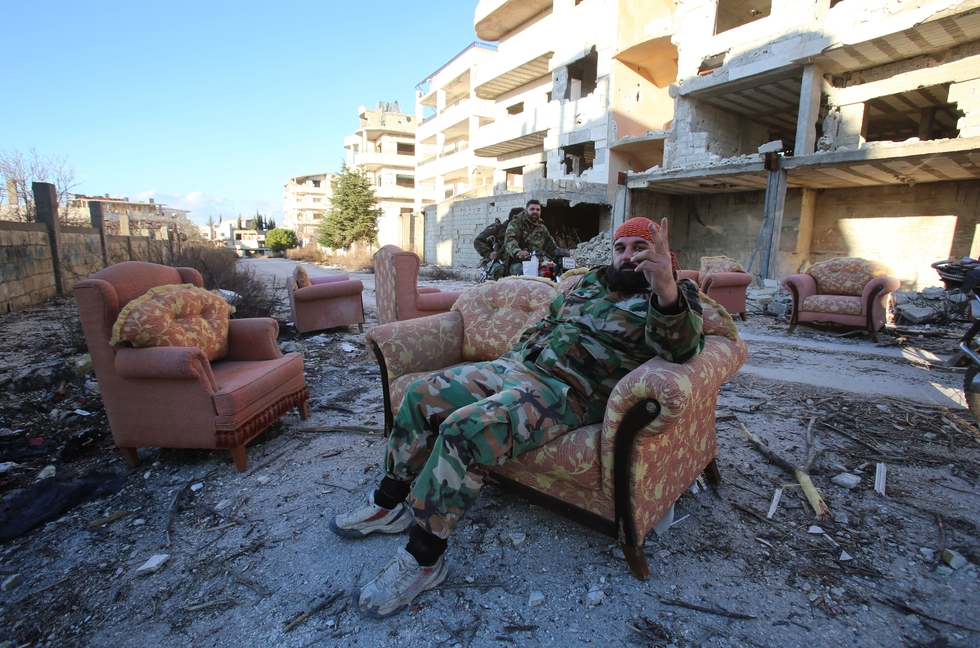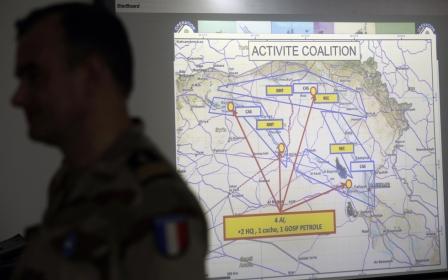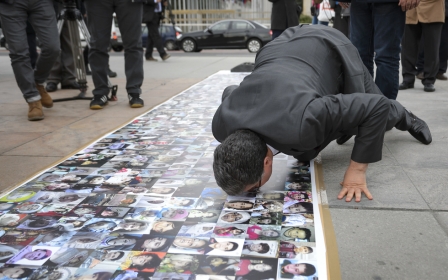Russia’s scorched earth policy in Syria

“It’s like Stalingrad. They raze entire areas. Then they send in the militias,” Yamen Ahmad, an FSA commander in Latakia, described. He was in Selma, Latakia province, leading his brigade when the regime took back the area from the opposition in January. “There is no way to resist this scorched earth policy the Russians are deploying with their strikes across Syria.”
Since Russia began its strikes in Syria on 30 September, the regime has been able to make some gains across the country. Despite declaring that their military goal was strictly to target ISIS in Syria, studies have clearly documented their strikes have the main purpose of supporting the Assad regime’s military operations on the ground against moderate opposition forces, and have done little to seriously combat ISIS.
“Russia is simply acting as the regime’s air force against our moderate forces now,” said spokesman for the FSA’s Southern Front and defected officer Major Issam Al Reis. In Aleppo, the frontline between the regime and ISIS is a de facto safe zone, while they both focus their weaponry on opposition forces. As one media activist on the ground observed in the recent battle for Aleppo: “During the north Aleppo offensive, not a single Russian bomb hit ISIS - not a single ISIS attack hit Assad's front.”
Osama Abu Zeid, a legal advisor to the Free Syrian Army, returned from Syria three days ago. He described how Russian strikes were ignoring ISIS and in fact hitting Free Syrian Army forces while they were fighting ISIS in northern Aleppo countryside. He described the frontline between ISIS and the regime as “entirely peaceful”.
There is a clear pattern in military strategy when looking at the areas of recent gains in Latakia, Daraa and Aleppo. The regime was not able to make headway until the start of heavy Russian airstrikes which then pave the way for regime forces that are now composed almost entirely of foreign militia. In the Selma offensive, Yamen Ahmad stated that 75 percent of regime forces were foreigners. When they intercepted the radio communication, the orders were coming in Persian while the general chatter between the forces was in an unrecognisable language he described as “from mid-Asia”.
Scorched earth
In the south, the regime took over the town of Sheikh Miskin, in Daraa, which had previously been held by the FSA’s Southern Front for over a year. The regime’s operation began on 16 October, 2015, however, no significant progress was made until after 28 November when Russian air strikes started in the area. Russia conducted around 800 heavy air strikes on the area until it fell on 26 January, 2016. They are operating a “scorched earth policy that no force could stand up to,” the FSA’s Southern Front spokesman Major Issam Al Reis stated.
A Russian agency posted a video titled “Dead City Sheikh Miskin” which captured the grim aftermath of the operation with the utter devastation of the city. The FSA Southern Front’s statement after the fall of Sheikh Miskin, said that this operation was “not a success story for the regime but a demonstration of how much it relies on Russia as its airforce, and foreign militia as its ground troops in order to recontrol areas of the country.” Al Reis commented: “The reality is that regime is not able to reclaim one metre of land without Russia fully destroying the area with its strikes.”
The military strategy in Selma held parallels to Sheikh Miskin. Yamen Ahmad described how the regime had been trying to take the area from the opposition for over three years. There had been over 50 battles but with little regime success, he told me. When the Russians intervened with their strikes “they burned the entire area,” he said. In 40 hours there were over 150 airstrikes, in addition to 1,500 Grad missile strikes. “There was no way to resist this fire power.”
By the end of this operation around 80 percent of buildings in the area had been damaged or destroyed. “You can barely find a building that is untouched by these strikes.” He described a similar dynamic in the operation over Al Noba mountain, Latakia province, where Russian strikes had been so heavy that “no tree had been left standing, the mountain was totally burned.” Twenty five air strikes had been dropped on a one-square-kilometre area. This was followed by cluster bombs and an unidentified weapon that burned entire areas: “everything it touched turned completely black”. Human Rights Watch issued a report this week documenting Russia’s ongoing use of “internationally banned cluster munitions” across Syria.
Aleppo is the same story. Osama Abu Zeid described the recent case of the village of Ritian in northern Aleppo countryside. The battle for this village started with eight hours of Russian air strikes, the militia (Iranian, Afghani, Lebanese Hezbollah) failed to move in to take the village so there were another 12 strikes, but again the militia’s ground operation failed, so Russia undertook another 10 airstrikes, until FSA forces withdrew and the militia were able to take the area. “Any areas are taken over solely because of the Russian strikes,” and only after “total destruction,” said Abu Zeid.
Once regained, civilians cannot return; the extent of the destruction makes the areas inhabitable: “Who wants to live in piles of rubble?” Al Reis asked me. Sheikh Miskeen is now empty. No civilians want to return as the city is completely destroyed, the same goes for Selma.
Aid agencies issued a report this week detailing that 40,000 people had been displaced from Aleppo since late January and the “number of displaced is likely to surpass 100,000” as the operation continues. Turkish Prime Minister Ahmet Davutoglu said on Wednesday that Russia is carrying out ethnic cleansing in Aleppo.
Militia ground forces
There is a stark contrast between the heavy Russian firepower and corresponding weakness of regime ground forces and therefore their reliance on Shia militia. It was Shia militia that recently broke the opposition siege of Nubl and Zahra in northern Aleppo. Videos were published of the foreign militia’s triumphal entry into the towns as they were greeted by the local people.
On Wednesday a video was leaked showing Hezbollah complaining that a news channel was broadcasting the Syrian army advance in southern Aleppo when it was Hezbollah forces. However, once these militias take over an area, they rarely stay to secure the area. Twenty days ago, Abu Noor was leading an operation in Al Hoor village west of Selma. Previously this area had been hit by heavy Russian air strikes. His forces prepared well for the operation, expecting a heavy defence. But when they took over the area, they only found six Syrian soldiers and their captain guarding the area. The militia which had previously been involved in the operation had moved on, leaving only a handful of Syrian soldiers to guard the area. It was revealed on pro-regime pages that the captain had even tried to flee the area in his car but found his tyres had been taken by someone needing spares.
Al Reis commented: “The nature of regime forces now is that they use foreign militia to capture an area. But these militia don’t stay to guard the area, they want to move on to areas where they can gain more spoils, take more women. They are not interested in guarding these empty ones. And there are hardly any Syrians to stay behind to do this job.”
Sustainability of advances?
The characteristic of these regime advances begs questions about their sustainability: can ground be held sustainably with such weak ground forces, just under the rain of Russian strikes? “As long as Russian planes are in the sky, they can demolish everything underneath them,” said Yaman Ahmad. But if this changes they will always be vulnerable.
“Their aim is to terrify both civilians and opposition fighters,” said Abu Zeid. The regime doesn’t have the ground forces to secure the areas so fear is now their only weapon to encourage surrender of opposition areas. This fear is useful to gain concessions within negotiations.
Despite these losses there remained optimism: “Comparing the amount of firepower Russia is using to the amount of land the regime is regaining, it would take 200 years for Russia to reclaim the whole of Syria,” said Al Reis, also pointing out that Russia’s scorched earth policy is only useful in urban areas, while they face difficulties in rural terrain.
Watching the devastation unfold
These victories are not a demonstration of regime power, but an expression of Russian brute strength reducing Syria to rubble and labelling it a regime victory.
The destruction, casualty numbers and displacement from these recent gains chimes with a well known rumour about Maher al-Assad, Bashar’s younger brother, commander of the 4th Division in Damascus: he who was rumoured to say that when his father was in power the population of Syria was eight million, and if it means reducing the population of 24 million to this number in order to crush the uprising, that’s what he would do.
Whether this comment it true or not, the reality is shaping up as such and it seems that Russian military strategy in Syria is aiding such a sentiment. Meanwhile, similar to the Russian deployment of their scorched earth policy in Stalingrad in World War II, Western powers are acting like their allies, standing by and watching the devastation unfold.
- Lara Nelson has been a consultant for the political and military sides of Syrian opposition since 2013. Previously, she was a senior political adviser in the British Parliament, focusing on the Middle East. She has also worked in Palestine, in the West Bank and then in the Gaza Strip after Operation Cast Lead 2008-2009. She speaks Arabic and holds an Oxford University degree in Theology, specialising in Islam, and an MA in International Relations and Diplomacy from SOAS, University of London. During 2013 she was a guest researcher at the Harvard Kennedy School’s Middle East Initiative.
The views expressed in this article belong to the author and do not necessarily reflect the editorial policy of Middle East Eye.
Photo: A member of the Syrian pro-government forces sits on a sofa in the strategic town of Salma, in the coastal Latakia province, on 15 January, 2016, following its recapture from rebel fighters (AFP).
Middle East Eye propose une couverture et une analyse indépendantes et incomparables du Moyen-Orient, de l’Afrique du Nord et d’autres régions du monde. Pour en savoir plus sur la reprise de ce contenu et les frais qui s’appliquent, veuillez remplir ce formulaire [en anglais]. Pour en savoir plus sur MEE, cliquez ici [en anglais].





